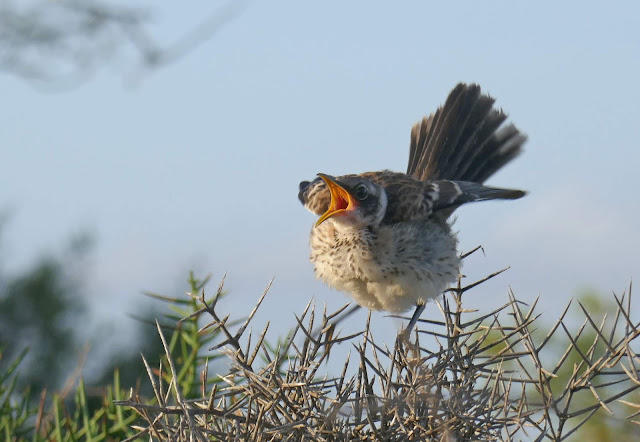4. Galapagos - Exhilarating
covering 2 - 16 March 2019
What was very different about this eight day cruise from
our usual laissez-faire attitude trips was that everything was organised for us. Where we went, what we did and what time we
did it. There were some very early
starts with us leaving the boat at 6.00 in the morning. There were a number of overnight cruises of
eight or nine hours so that we were in place for a different island trip the
next morning. Every day had three or
four activities of walking or snorkelling and it was a pretty intense eight
days.
 |
| Nazca Booby - note the more conservative footwear |
 |
| Galapagos Land Iguana |
 |
| young Mockingbird begging for food |
I mentioned it in an earlier Galapagos blog but the
one thing that would surprise most people is just how close it’s possible to get
to the birds and animals. They’ve lived
in isolation for so long that an innate fear of humans has never developed. It is quite normal here to walk past a
nesting or resting bird only a few feet away and they just don’t bother to
move. One other thing about endemic
birds on remote islands is that they’re often quite dull rather than being
flamboyantly coloured. Oh, and ‘endemic’
in wildlife terms means found nowhere else in the world.
 There are of course many non-endemic creatures here, particularly seabirds. Lots of Grey
Pelicans with what seem like ridiculously huge beaks which dive at breakneck
speed into the water to catch fish.
They’re also the most wonderful gliders, often in a line as they skim
the surface of the sea riding and falling gently with the height of the waves
beneath them. The Boobies dive in a
similar fashion, bending their wings back to what looks like a dislocated angle
as they hit the water. We saw
Blue-footed and Nazca Boobies but missed the Red-footed ones because we didn’t
get to the right islands. Well we
couldn’t do everything and the interest of spotting wild creatures is that you
can never be sure that they’re where they’re expected. There’s also a good spread on different
islands of American Flamingoes, very pink and with what also look like bizarre
beaks which they use to sieve the water for food. The birds are usually benign arrivals but
the ones that are not are brought in deliberately or accidentally by man -
mice, rats, cats and dogs which can all cause havoc in a population of birds
and animals which don’t have them as natural predators.
There are of course many non-endemic creatures here, particularly seabirds. Lots of Grey
Pelicans with what seem like ridiculously huge beaks which dive at breakneck
speed into the water to catch fish.
They’re also the most wonderful gliders, often in a line as they skim
the surface of the sea riding and falling gently with the height of the waves
beneath them. The Boobies dive in a
similar fashion, bending their wings back to what looks like a dislocated angle
as they hit the water. We saw
Blue-footed and Nazca Boobies but missed the Red-footed ones because we didn’t
get to the right islands. Well we
couldn’t do everything and the interest of spotting wild creatures is that you
can never be sure that they’re where they’re expected. There’s also a good spread on different
islands of American Flamingoes, very pink and with what also look like bizarre
beaks which they use to sieve the water for food. The birds are usually benign arrivals but
the ones that are not are brought in deliberately or accidentally by man -
mice, rats, cats and dogs which can all cause havoc in a population of birds
and animals which don’t have them as natural predators. |
| Sting Ray |
 |
| Spotted Eagle Ray |
We did get the very
strong impression that the conservation here is taken very seriously
indeed. Litter is scarce and when on
one island we saw some washing around in a tide pool eight feet or so below
when we were standing, our guide climbed in and collected it all. He would also pick up any small pieces of
rubbish as we walked around.
Our on-board chef managed to produce three meals a day from a tiny galley for us sixteen passengers and the five crew which was a bit of a conjuring trick really. We had brought some snacks in case the food wasn’t to our taste but we ended up not eating any of our iron rations. There was also enough space on board to get away from people if we wanted without going to our tiny cabin in which Heather kept her case on the end of her bunk. We also learned to try avoiding taking a shower when the boat was moving because it moved in a lot of directions.

















More brilliant photos!
ReplyDelete